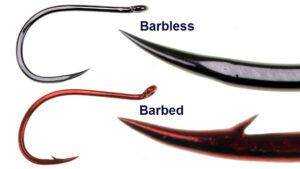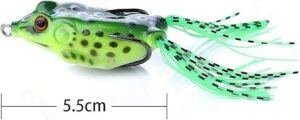Fishing For Bass Using Barbless Hooks
I’m going to walk you through the art of fishing for bass using barbless hooks, a practice that’s gaining traction among anglers. You might wonder why make a switch to barbless hooks when the traditional barbed ones have been doing the job for years. Well, this isn’t just about catching fish; it’s also about mindful fishing and the broader impact on our aquatic ecosystems.
Now, barbless hooks offer several advantages that go beyond just the catch. You’re going to find out about their benefits not only for the angler’s experience but also for the health and welfare of fish populations. It’s an approach that aligns with the principles of catch-and-release fishing, ensuring that bass can be returned to the water with minimal harm.
By choosing to fish with barbless hooks, you’re stepping into a role of responsible stewardship towards the environment. It’s a simple yet profound change that can have far-reaching positive consequences. And don’t worry too much about the effectiveness of your fishing; many pros have demonstrated that barbless hooks can be just as successful, if not more, than their barbed counterparts when used correctly.
What You Need to Know About Barbless Hooks
Understanding barbless hooks is crucial for any angler looking to fish responsibly. Commonly misconceived as less effective, these hooks are designed precisely to ensure a secure catch while minimizing harm to the fish. Let’s demystify what barbless hooks are and how they stack up against their barbed counterparts.
Barbless hooks are just what they sound like: hooks without the traditional barb. Barbs are small backward- pointing spikes intended to prevent a fish from unhooking. On a barbless hook, the absence of a barb allows for a smoother and quicker release, making it a more humane option. This isn’t just about being kinder to fish; it’s also about preserving the quality of the catch for those practicing catch-and-release fishing.
pointing spikes intended to prevent a fish from unhooking. On a barbless hook, the absence of a barb allows for a smoother and quicker release, making it a more humane option. This isn’t just about being kinder to fish; it’s also about preserving the quality of the catch for those practicing catch-and-release fishing.
When it comes to bass fishing, the debate between barbed and barbless hooks is ongoing. Some anglers are concerned about losing their catch without a barb to secure it. However, many experienced bass fishermen find that with proper technique, barbless hooks offer a reliable hold without sacrificing the fish’s well-being. This can include maintaining tension on the line and ensuring a proper hook-set.
There’s a vast selection of barbless hooks available on the market, catering to various fishing styles and bass sizes. If you’re undecided on which to choose, look for hooks specifically labeled ‘barbless’ or modify existing barbed hooks by crushing the barb with a pair of pliers. Choose something that resonates with you – your comfort with the hook will translate into better fishing technique.
Keep in mind that certain regions have regulations requiring the use of barbless hooks. Always stay informed about local fishing laws to ensure you’re in compliance. Next up, I’ll guide you through gearing up for an ethical bass fishing trip, focusing on the right equipment for barbless hooks and the significance of a sustainable approach.
Equipping Yourself for Ethical Bass Fishing
Choosing the right fishing gear is crucial when targeting bass with barbless hooks. I’m going to help you find a setup that not only makes fishing more efficient but also promotes ethical practices.
For starters, you’ll want to focus on selecting a rod and reel combination that offers enough sensitivity and strength. This is because you need to feel the slightest nibble and set the hook quickly without the barb. A medium to medium-heavy action rod paired with a high-quality reel that has a smooth drag system is going to be essential.
In my opinion, the line you choose plays a significant role too. You want a line that’s strong and has low memory to ensure direct contact with the bait. That’s going to include options like fluorocarbon or braided lines, which offer low stretch and high sensitivity.
Don’t worry too much about the bells and whistles of advanced gear. The best approach is to choose something that resonates with you, ensuring it’s comfortable for long hours of fishing. A comfortable grip on your rod and a reel that matches your preferred fishing style are more critical than the fanciest gear on the market.
You can always adjust your approach down the road, but starting with a simple, sturdy setup will help you fulfill your role as a conservation-minded angler. By using barbless hooks and appropriate gear, you’re playing a part in ensuring bass populations remain healthy for generations to come.
Advanced Techniques for Successful Bass Fishing with Barbless Hooks
Mastering bass fishing with barbless hooks involves adapting your technique to ensure you’re as effective, if not more so, than when using traditional barbed hooks. It’s paramount to understand that keeping the line tight is crucial. Any slack can give bass the chance to throw the hook because without the barb, there’s less to prevent their escape. I’m going to guide you through some advanced techniques that can elevate your barbless hook fishing to new heights.
First off, casting accuracy becomes even more important with barbless hooks. Position your lure to tempt bass out of their hideouts with precision; this isn’t just about getting the hook into the water, it’s about placement that minimizes the fish’s ability to find leverage to dislodge the hook. Hone your targeting skills and you’ll notice a difference in your success rates.
You’ll also want to adjust your retrieval speed. A slow, steady retrieve can often be key with barbless hooks, as erratic or fast movements may give the bass too many opportunities to shake off the hook. The steadier your retrieve, the fewer chances the bass has to become unhooked.
In my opinion, choosing the right line is also a major part of your advanced technique. Some anglers prefer a more forgiving line that has a bit of stretch, which can act like a shock absorber and reduce the risk of the hook pulling free. Others go for a stiffer line for a more direct feel and faster hookset. Test different lines to find something that resonates with you and suits your fishing style.
Set the hook with care but confidence. With barbless hooks, a gentle yet firm hookset is often more effective than a hard snap, which could tear the mouth of the fish or let the hook slip out entirely. Your rod’s responsiveness and flexibility can aid in this delicate balance.
Common Challenges and Solutions When Fishing for Bass with Barbless Hooks
I’m going to level with you: fishing for bass with barbless hooks can sometimes feel like you’re upping the difficulty level. But don’t worry too much about that. These challenges often teach you to become a more skilled angler. Here are some of the handy solutions to turn those little obstacles into opportunities.
Maintain the Integrity of the Hook-Set
Maintaining a solid hook-set is critical when using barbless hooks, because without the barb, there’s less to prevent the hook from slipping. To tackle this, make sure you’re setting the hook with a swift, firm motion, and keep your line tight at all times.
Handle with Care to Protect the Bass
When you do land that bass, remember to handle it as little as possible and keep it submerged in water. If you need to remove it from the water, support the bass horizontally and avoid squeezing too tightly, which can damage its internal organs.
Proactive Solutions to Unhooking Issues
Sometimes, bass will manage to free themselves before you can even react. The key here is to keep the line taut and stay attentive to the bass’s movements. Using a heavier line than you might with barbed hooks can also help keep the fish on the line.
Mastering the Art of the Gentle Release
Releasing the bass gently back into the water not only feels rewarding, but it also helps ensure the fish’s survival. Revive the bass if necessary by holding it in the water, allowing it to swim away when it’s ready.
Conservation Matters: The Role of Anglers in Protecting Bass Populations
I’m going to wrap up our discussion by emphasizing the critical role that anglers like you play in safeguarding the future of bass populations. This isn’t just about using barbless hooks; it’s also about adopting practices that ensure the health and survival of these incredible fish for generations to come.
You’re going to find out about how every catch-and-release moment is an opportunity to contribute to conservation. By practicing effective catch-and-release with barbless hooks, you’re reducing the stress and injury to bass, which significantly enhances their chances of survival post-release.
Choose something that resonates with you, whether it’s volunteering for habitat restoration projects or advocating for sustainable fishing laws. Remember, your actions have a ripple effect on the entire ecosystem.
I really hope that you’ll take these insights and not only apply them to your own fishing adventures but also share them with fellow anglers. Through collective effort and enhanced awareness, the angling community can lead the way in protecting our waterways and the bass that thrive within them.
Lastly, let’s stay informed and be ready to adjust our methods as new research and guidelines emerge. Don’t worry too much about getting it perfect from the start; conservation is an evolving practice, and you can always refine your approach down the road.
Thanks for being a part of this journey towards more ethical and sustainable bass fishing. Together, we can make a real difference. And as you continue to enjoy the sport, remember that by choosing barbless hooks and respecting the waters you fish in, you’re making a strong statement for conservation. Tight lines and take care!


